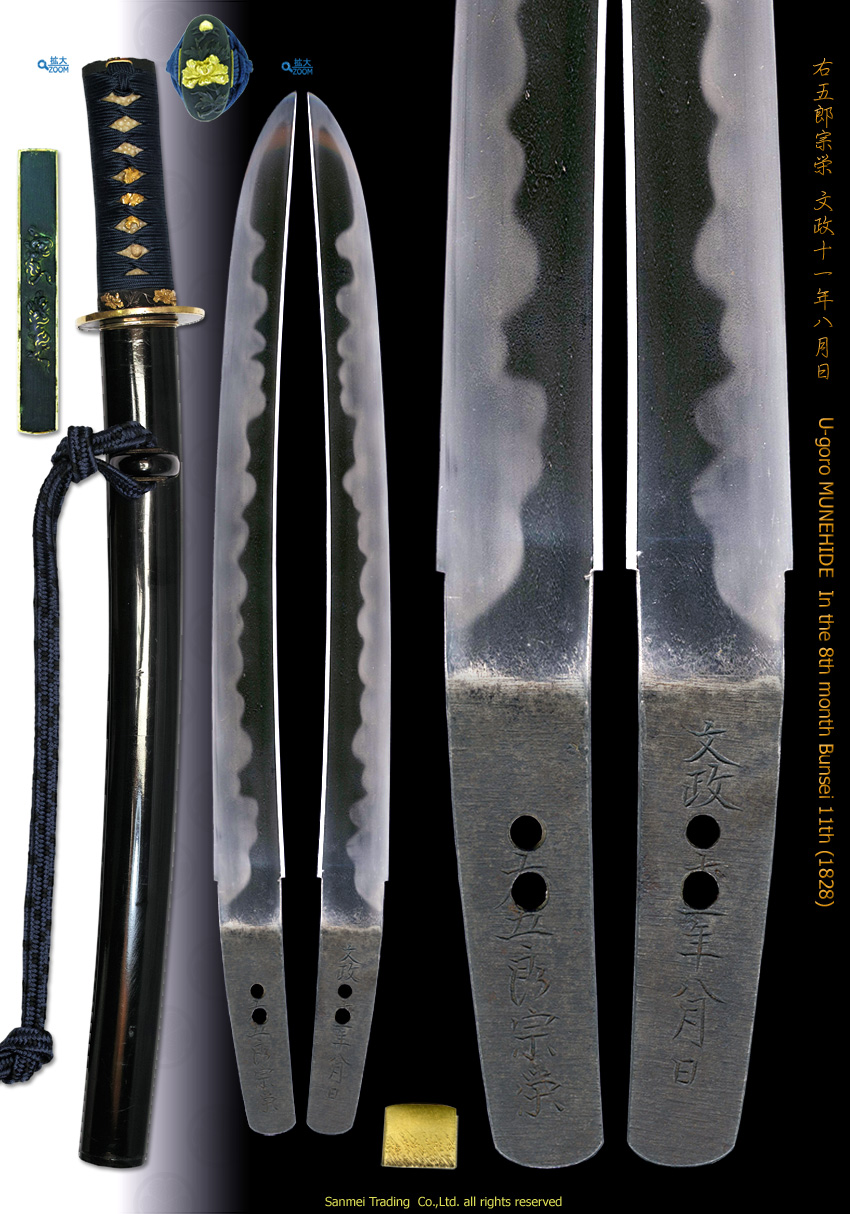with) Black Roiro lacquered scabbard Chi'sa katana style Koshirae
Length of cutting edge 32.7cm Curvature 0.6cm Width of base 29.6mm Thickness of base 6.2mm
Forging(Hada): Forging mark is fine Ko-Itame mixing in with precise Mokume-burl ware. The superior forged steel under careful tempering gives off clear Nie sparkling hard metal granules "Ji-nie" on Hira-ji surface and darkish lines of Nie so called "CHIKEI" activity that wells out from steel. "Yubashiri" - sparkling Nie granules appears on Hiraji that radiates from heads of Gunome and Choji. Some indication of "Yubashiri" isolated Muneyaki appears here and there along back ridge.
Temper(Hamon): Hamon is a bit on coarse side Nie hard metal granules base, large Gunome-midare and tall Choji clove-outline in high and varies in shape. Deep sparkling Nie accumulates along quenching area especially deeper on the gorges of Gunome-outline where interior is filled with mist-like crystallize area deeply with thick feet of ASHI and long lines of streaming Nie of SUNAGASHI areas. The entire temper gives off the most flamboyant impression based on Soushu tradition.
Temper of tip(Boshi): Temper of boshi forms a tall Choji-ha in upper Fukura point then straight medium circle in a good manner then deeply turns back.
Tang(Nakago): Nakago is in UBU original. Two peg holes of Mekugi-ana. U-shaped (Kurijiri) on bottom heel. The filemark is shallow katte-sagari (slanting left) and back ridge of Nakago is well-rounded contours to show greatly slanting left file mark (Ō-sujikai). The signature in front is five character that starts from the artistic title pseudonym of Ugoro 右五郎 and smith name MUNEHIDE 宗栄. The other side is chiselled the date of year In the 8 th month Bunsei 11 th (1828).
The founder 1st generation smith MUNEHIDE 宗栄 who was active early Edo period, lived in Sakamoto-town, a couple of hundred meters northwest apart from Himeji castle (now a point on Green Hotel). The previous maker of MUNEHIDE 宗栄 was MUNENAGA 宗長 in Obama city, Wakasa province, who was invited during Tensho-Bunroku (1573-1592) to come to city of Himeji by the military commander Akamatsu Masahide 赤松政秀.
The smith MUNEHIDE 宗栄 initially lived at Chikusa 千種, Shisou-gun where has been the most famous area of fine steel from ancient times.
The Himeji feudal lord Matsudaira Naonori 松平直矩 promoted him in recognition of his achievements to be an official sword maker under contract to the Himeji clan. After Matsudaira Naonori 松平直矩 was transferred to Bungo province on Keian 1st (1648), he was contracted to the Okayama feudal lord Ikeda Tsunamasa 池田綱政.
The subject Wakizashi is identified as the 4th generation of MUNEHIDE 宗栄 from it's date of year Bunsei 11 (1828) inscribed on Nakago, who lived in Himeji-castle town under patronage of Sakai clan.
The blade is longer and thicker than average, solidly heavy built. These would be the evidence to prove that this katana was carefully made in his prime on the special demand from high class Samurai using selected the top quality fine steel so called Chikusa-tetsu 千種鉄 to give off vividly clear lights. In view of Nakago, it remains fine taste of patina, clear filemarks and energetic chiselled inscription further to add histrical value with the date of year, those remains an excellent condition.
with) Black Roiro lacquered scabbard Chi'sa katana style Koshirae (click HERE for entire Koshirae and HERE for each fitting)
- Fuchi/kashira : Botan peony design, Shakudo ground, Nanako-ji surface, Takabori gold Iroe, unsigned
- Menuki : Shishi lion and lioness design, Yobori carving gold plated
- Kozuka : Shishi lion and lioness design, Shakudo ground Takabori carving, golkd Iroe, back plate gold plated, unsigned
- Tsuba : Polish surface, Shakudo ground, Gold Fukurin rim, unsigned
- Tsuka : White layskin, blue silk cord lozenge wrap
Recent good polish/Condition scale: excellent (using a scale of mint-excellent-very good-good-fair-poor)
reference data : Honma Kunzan/Ishii Masakuni, Nihonto meikan, Yuzankaku, 1975



